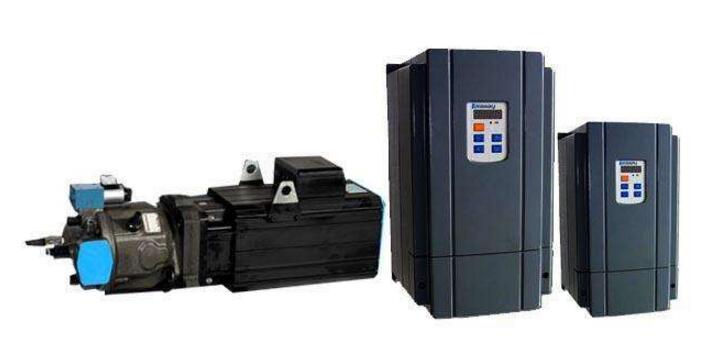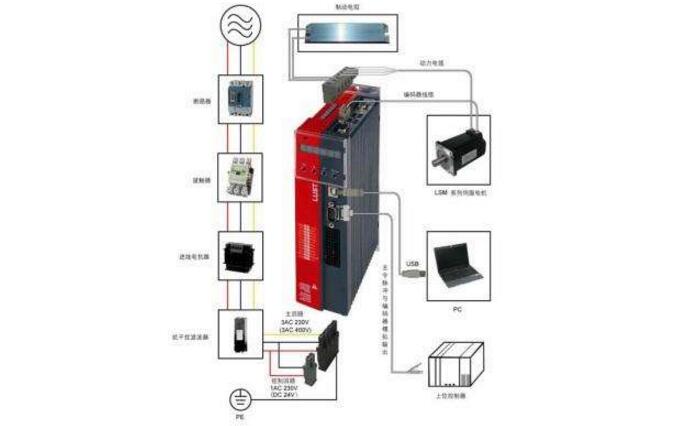The structure and types of mechatronic servo control system are numerous. However, from the perspective of automatic control theory, the servo control system generally includes five parts: controller, controlled object, execution link, detection link, and comparison link. The figure below shows the block diagram of the servo system.

Figure servo system composition block diagram
1. Comparison
The comparison step is to compare the input command signal with the feedback signal of the system to obtain the deviation signal between the output and the input, usually by a special circuit or computer. 
2. Controller
The controller is usually a computer or PID control circuit. The main task of the controller is to transform the deviation signal output by the comparison element to control the actuator to perform the required action.
3. Execution
The role of the execution link is to convert various input energy into mechanical energy according to the requirements of the control signal to drive the controlled object to work. Actuators in mechatronic systems generally refer to various motors or hydraulic and pneumatic servos.
4. The controlled object
5. Detection
The detection link refers to a device that can measure the output and convert it into the dimension needed for the comparison, and generally includes a sensor and a conversion circuit.
Servo system working principleThe servo system is an automatic control system that changes the position, orientation, and status of the object such that the controlled variable can follow any change in the input target, that is, the servo system is a closed loop automatic control system with feedback. It consists of a computer digital control system, servo drives, servo motors, speed and position sensors. The computer digital control system is used to store the parts processing program, perform various interpolation operations and software real-time control according to the information fed back by the encoder, and sends out various control commands to the servo drive system of each coordinate axis. After the servo driver and servo motor receive the control command of the computer digital control system, the power is amplified, transformed and regulated, and the speed can be quickly and smoothly adjusted, and the position control can be performed accurately.
Servo system classificationJudging from the nature of the components of the system, there are electrical servo systems, hydraulic servo systems, electrical-hydraulic servo systems, and electrical-electrical servo systems;
From the physical properties of the system output, there are speed or acceleration servo systems and position servo systems;
From the characteristics of the components and signals in the system, there are analog servo systems and digital servo systems.
From the structural characteristics of the system, there are single-feed servo systems, multiple-feed servo systems, open-loop servo systems, and closed-loop servo systems.
The servo system is divided according to its driving elements, such as a stepping servo system, a direct current motor (referred to as a direct current motor) servo system, and an alternating current motor (referred to as an alternating current motor) servo system.

1. Basic requirements for servo system
(1) Good stability: Stability means that the system can reach new or return to the original equilibrium state after a brief adjustment process under given input or outside interference.
(2) High precision: The accuracy of the servo system refers to the precise degree of output that can follow the input. As a precision machined CNC machine tool, the required positioning accuracy or contour processing accuracy is usually high, and the allowable deviation is generally between 0.01 and 0.001 mm.
(3) Fast response: Fast response is one of the symbols of the dynamic quality of the servo system, that is, the response of the tracking instruction signal is required to be fast. On the one hand, the transient process requires a short time, generally within 200 ms, and even less than tens of milliseconds; On the other hand, in order to meet the overshoot requirement, the frontier of the transition process is required to be steep, ie, the rate of increase is large.
2. The main features of the servo system
(1) Accurate detection device: Closed-loop control with composition speed and position.
(2) There are multiple feedback comparison principles and methods: According to different principles of information feedback implemented by the detection device, the method of feedback comparison of the servo system is not the same. At present, there are three kinds of pulse comparison, phase comparison and amplitude comparison.
(3) High-performance servo motors (servo motors for short): CNC machines for high-efficiency and complex surface machining. Servo systems will often be in frequent starting and braking processes. The ratio of the output torque to the moment of inertia of the motor is required to produce a sufficiently large acceleration or braking torque. The servo motor is required to have a sufficient output torque at a low speed and run smoothly so as to minimize the intermediate links in the connection with the mechanical movement part.
(4) Speed ​​adjustment system with wide speed range, ie speed servo system: From the control structure of the system, the position closed loop system of CNC machine tools can be regarded as a double closed loop automatic control system in which the position is adjusted to the outer ring and the speed is adjusted to the inner ring. The actual working process of the system is to convert the position control input into a corresponding speed reference signal, and then drive the servo motor through the speed control system to achieve the actual displacement. The main movement of CNC machine tools requires higher speed control performance, so the servo system is required to be a high-performance, wide-speed control system.

In CNC machine tools, servo control system is an indispensable part. Its task is to translate the numerical control information into the machine feed motion to achieve precise control. The application of servo system in some automatic machinery equipment is very extensive. Especially in the general trend of automatic production development, the application of servo system becomes more and more important. At present, China is promoting the automation of industrial manufacturing. In this process, a large number of industrial robots and machine tools are needed. In these devices, the servo system has a very important application in the overall control.
Among them, the role of the CNC machine tool servo system is to accept the command signal from the numerical control device, drive the moving part of the machine tool to follow the instruction pulse motion, and ensure the fast and accurate action, which requires high-quality speed and position servo. The above mainly refers to the feed servo control, in addition to the servo control of the main movement, but the control requirements are not as high as the former. The technical specifications of CNC machine tools such as accuracy and speed often depend mainly on the servo system.
Since CNC machine tools require high product processing, the servo control system used is critical. The advantages of the servo control system currently used on CNC machine tools are: high accuracy, and the accuracy of the servo system refers to the precision of the output quantity to reproduce the input quantity. Including positioning accuracy and contour machining accuracy; stability is good, stability refers to the system under a given input or outside interference, after a brief adjustment process, to reach a new or restored to the original equilibrium state.
Board To Board Power Connector
Board To Board Power Connector,Power Board-To-Board Connector,Signal Plus Power Connectors,Power Industrial Connectors
Dongguan SOLEPIN Electronics Co., Ltd , https://www.wentae.com